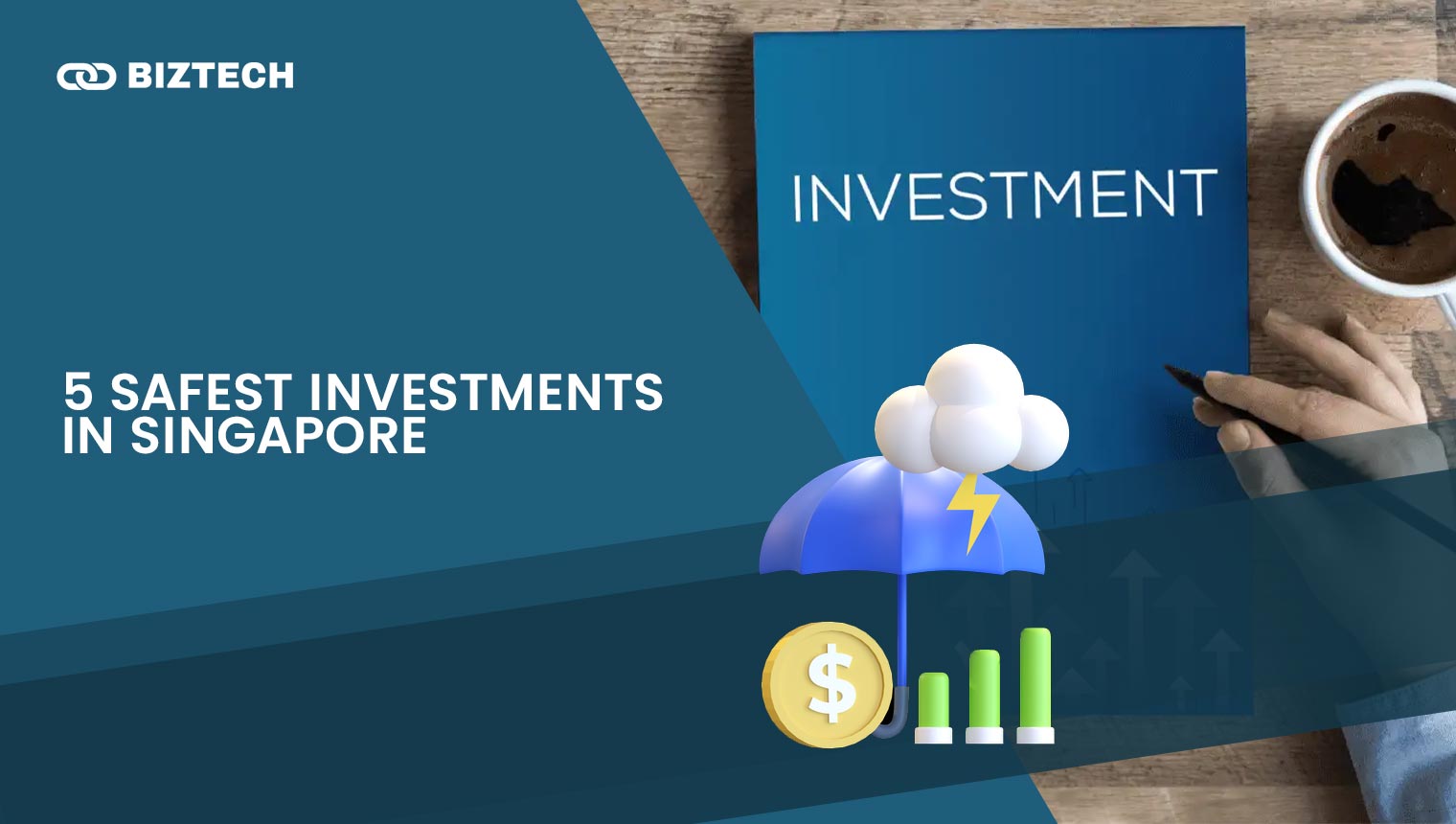Although investing in Singapore presents many possibilities, safety comes first for many investors. Whether your goals are simple wealth growth with low risk, saving for a major life event, or retirement planning, knowledge of the safest investment choices is vital.
Renowned for its steady economy and robust legal system, Singapore offers a variety of safe investment options to suit varying risk tolerance and financial objectives.
From government-backed securities to reliable financial goods, this article looks at some of the safest investment possibilities accessible in Singapore, thus helping you make wise decisions to preserve and increase your hard-earned money.
Why You Should Start Investing?
Creating better financial practices
Since investments are a type of financial commitment, they will cut into your disposable income until you start seeing returns. Given lower disposable income, you may consider overpaying twice on specific expenses. Therefore, choosing the finest online brokerage with reduced costs and minimal extraneous charges can help you maximize your assets.
Before you choose one, consider evaluating several online brokerages using MoneySmart’s tool to avoid regretting and paying any unwarranted fees and expenses.
Saving for a particular fund
Whether it’s for a wedding, your child’s school, retirement, or another cause, investing can help boost your savings for a major outlay in less time than depending only on your monthly income with no additional returns.
Growing your wealth
Once you start investing, you are opening doors to higher returns as you learn to take more risks with smart strategy and careful planning. Whether your income is disposable or saved, you will eventually get the swing of things and be able to satisfy your financial needs and raise your wealth.
Why Focus on Safe Investments?

Understanding why you may choose safer investments over more high-risk chances will help you better appreciate particular investing possibilities. Though they have smaller returns than high-risk investments, safe ones also have less chance of losing your principal money.
It is vital if you have long-term plans like retirement, savings for your child’s school, or want a consistent income source free from market volatility.
Key Factors to Consider for Safe Investment
Examining the safety of an investment should take these elements into account:
- Liquidity: How quickly could you turn your investment into cash without losing value? Generally speaking, highly liquid investments are safer.
- Support of Government: Generally speaking, government-sponsored or insured investments are safer. That is because governments are less likely than commercial enterprises to default.
- Capital Protection: Search for investments where the initial investment of funds is either minimally open to loss or secured.
- Variability of the market: A safe investment is usually less volatile. Reduced volatility implies the value of your investment won’t swing greatly depending on the state of the market.
For Muslim investors, please check out our list of halal investment options and strategies.
Assessing Your Risk Tolerability
A personal assessment of your capacity for risk tolerance guides your investment portfolio. Variables affecting risk tolerance consist of:
- Financial Goals: While long-term goals (like retirement) could withstand higher risk, short-term aims—like purchasing a house—may call for safer investments.
- Financial Stability: Your present financial condition, including income, savings, and other investments. Usually, more stability lets one tolerate more danger.
- Investment Horizon: How long do you intend to keep an investment before you require access to your funds? Greater danger can be tolerated on longer horizons.
Types of Risk Tolerance:
Conservatives prioritise capital’s safety over any rewards. This approach is perfect for individuals who want to protect their fortune.
- Moderate: eager to take some risk for more profits. Appropriate for people with a measured approach.
- Aggressive: At ease with more chance of bigger gains. Ideal for folks with long-term aspirations and a good financial background.
5 Safest Investments in Singapore

1. Singapore Savings Bonds (SSBs)
What Are SSBs?
Among the safest accessible investments in Singapore are savings bonds.
Issued by the Singapore Government, these bonds promise a guaranteed return if held to maturity and are supported by the government. They are meant for those who wish to generate consistent, risk-free returns over time.
Key Benefits of SSBs
- Protecting capital: You invest mostly in SSBs, which are completely secured.
- Tenive Flexibility: Although SSBs have a 10-year term, you can redeem them any time before maturity without losing your principal.
- Steady returns: Long-term savers find SSBs appealing since their returns will increase.
- Low Minimum Investment: Investing in SSBs with as low as SGD 500 is doable.
How to Invest in SSBs
SSB investing is easy. Local banks, including DBS, OCBC, and UOB, let you apply using their online banking systems. Once accepted, the bonds appear in your Central Depository (CDP) account, where interest will grow until you decide to redeem them.
Who Should Consider SSBs?
Conservative investors seeking a safe place to save their money with moderate returns and who prioritize capital protection will find SSBs perfect.
2. Singapore Government Securities (SGS)
What Are SGS?
The Singapore Government publishes debt instruments known as Singapore Government Securities (SGS). These comprise bonds, T-bills, and Treasury bills. SGSs are among the safest investments accessible, as the government sponsors them, like SSBs.
Key Benefits of SGS
- Government Backing: The Singapore Government guarantees SGS, just as SSBs.
- SGS bond tenure ranges from two to thirty years, providing flexibility in investment length.
- Steady returns: SGS gives consistent returns expressed as regular interest payments.
- Liquidity: Traded on the Singapore Exchange (SGX), SGS can be sold before maturity if the market demands it.
How to Invest in SGS
You can make SGS investments via local banks or brokerage companies. Because SGS bonds are on the secondary market, buying and selling them as needed is simple.
Who Should Consider SGS?
Investors seeking a stable, long-term investment with Singapore Government backing would find SGS appropriate. They are also suitable if you mix bonds and stocks in your investment portfolio.
3. Cash Management Accounts
Cash management accounts (CMAs) have become a popular low-risk investment choice for people wishing to increase their savings with higher returns than standard savings accounts.
Usually presented by digital financial platforms and robo-advisors, these accounts combine liquidity, reasonable rates of interest, and simplicity of operation.
What are Cash Management Accounts?
CMAs are meant to increase your cash’s interest while keeping great liquidity. They combine your money with other investors and invest it in various low-risk products, such as money market funds and short-term bonds. This strategy keeps your money accessible while helping to generate better returns.
Key Features of Cash Management Accounts:
- Competitive Rates of Interest: CMAs usually have better interest rates than standard savings accounts. These rates vary and rely on the underlying investments’ performance.
- High Liquidity: CMAs mainly offer great liquidity, which is one of their advantages. Usually free from penalties, you can take your money at any moment, which qualifies for emergency funds and temporary savings.
- Ease of Management: These accounts are simple to set up and handle through digital platforms, and their features—automatic deposits and withdrawals—offer a user-friendly experience.
- Low Fees: CMAs usually offer modest costs relative to conventional investing accounts. Depending on investment length or account balance, certain sites could even provide charge waivers or lowered rates.
Why Choose Cash Management Accounts?
For individuals who wish to get more returns on their cash without running any major risk, CMAs are a great option. Those who want a flexible, low-risk investment choice or who require quick access to their money will mainly find them appropriate.
CMAs are a convincing substitute for conventional savings accounts and fixed deposits because they combine competitive interest rates, great liquidity, and simplicity of operation.
4. Regular Savings Plans (RSPs)
RSP earnings range since these programs usually invest in exchange-traded Funds (ETFs), Real Estate Investment Trusts (REITs), and blue-chip equities.
Your returns rely on how these assets perform. Instead of pinpointing specific earnings, you should pay more attention to important transaction fees.
Safety of Regular Savings Plans (RSPs)
Unlike fixed deposits, RSPs do not provide assured returns over a set term. They depend on the DCA concept, which uses funds’ long-term growth potential and equities’. Your confidence in benefitting from RSPs will show in your belief in the market’s long-term increasing trend.
Key features of Regular Savings Plans (RSPs)
- Dollar-Cost Averaging (DCA): This approach allows you to make consistent fixed-amount investments regardless of the market’s state. It averages the purchase price of investments over time, reducing the effect of market volatility.
- Market Exposure: Regular investments help you weather transient swings and profit from the long-term expansion of the market.
- Accessibility: RSPs are appropriate for beginners and others who want to monitor the stock market closely. Their minimal investment is S$100, making them a convenient starting point for new players.
- Medium- to Long-Term Horizon: RSPs are meant to be a significant investment portfolio over time, not for rapid returns.
- Effortless Investment: The system guarantees consistent regular investing free from market timing requirements.
How Much to Invest Each Month?
Figure your monthly investment based on your financial goals, risk tolerance, and general affairs. Start small—especially if you are new to investing—then progressively raise your contributions as your financial circumstances improve and you grow more easily.
Successful investment with RSPs depends mostly on consistency and a clear awareness of your financial capability and objectives.
5. Endowment Plans
Endowment plans are protection and savings combined insurance policies. They aim to enable you to reach particular financial objectives, such as retirement savings or financing your child’s education.
Usually including possible incentives, endowment programs provide a guaranteed return.
Key Benefits of Endowment Plans
Most endowment programs guarantee a certain investment return, safeguarding your principal.
- Endowment plans sometimes incorporate life insurance, giving your loved ones financial protection should you die.
- Structured Savings: Endowment plans demand recurring premiums over a certain term, promoting disciplined savings.
- Potential Bonuses: In addition to assured returns, some endowment plans include non-guaranteed bonuses based on the performance of the insurer’s investment portfolio.
How to Invest in Endowment Plans
Singaporean insurance firms sell endowment plans. Understanding the terms and conditions, especially the surrender value, is important—what would you get should you cancel the plan before it fully matures?
Who Should Consider Endowment Plans?
Endowment plans are perfect for those seeking a disciplined savings plan with guaranteed returns and the extra advantage of life insurance coverage.
Safe Investment Tips for Beginners in Singapore

Diversification: Spreading Your Risk
Managing risk depends on diversification. Diverse asset classes help you minimise the effect of any investment’s bad performance on your whole portfolio. Adequate diversification follows these guidelines:
- Mix Asset Classes: Combine more risk choices like REITs and equities with safer assets like government bonds and fixed deposits. This combination brings risk and reward into harmony.
- Different Time Horizons: To meet different financial needs, combine long-term investments (such as CPF Special Account) with short-term ones (like T-Bills).
- Geographic Diversification: Though this article mostly addresses Singapore, consider diversifying your investments internationally to distribute risk among several countries.
Forty per cent of a well-diverse portfolio might be Singapore Savings Bonds, 20 per cent fixed deposits, 20 per cent REITs, and 20 per cent Treasury Bills. This combination balances safety and growth potential.
Monitoring Economic and Market Conditions
Investment performance and safety depend on the larger economic surroundings. Here are some ideas:
- Interest Rate Trends: Rising interest rates will affect different assets. In a rising rate environment, fixed deposits and bonds could provide superior yields, while REITs could face difficulties.
- Inflation: High inflation can undermine actual returns. Since rental income is connected to inflation, investments like REITs could provide a better defense against inflation.
- Global Market Volatility: The global economic situation and market volatility can affect investing. Generally speaking, government-backed securities are safer during world uncertainty.
Lower interest rate fixed deposits may not keep up with inflation should inflation rates rise dramatically, lowering actual returns. On the other hand, REITs with rental income modifications could do better.
Seeking Professional Financial Advice
A financial adviser can provide individualised recommendations catered to your particular circumstances. They can support you:
- Assess Your Risk Tolerance: Know your degree of risk tolerance and suggest appropriate investments.
- Plan for Financial Goals: Match your long-term and short-term goals—such as buying a house or planning for retirement—with your assets.
- Monitor and Adjust: This service helps you constantly modify your portfolio based on changes in your financial circumstances and the state of the markets.
Example:
Based on your modest risk tolerance and objective of consistent income with some growth, a financial advisor might advise a portfolio of SSBs, FDs, and REITs.
Avoiding Common Investment Mistakes
Reducing common errors will help your investments to be safer. These are some traps to be aware of:
- Chasing High Returns: Many times, significant gains include more risk. Stay with assets that fit your risk tolerance rather than looking for high-return, high-risk possibilities. For instance, even if speculative stocks or cryptocurrencies could offer great gains, they also pose significant risks.
- Ignoring Inflation: To maintain buying power, ensure your assets pay returns faster than inflation. If inflation rates climb noticeably, consider investments with inflation protection. One way to help reduce this risk is via REITs or inflation-linked bonds.
- Lack of Diversification: Investing all your money in one asset class or investment can be dangerous. Spread risk and increase your chances of consistent returns by diversifying among several kinds of assets, industries, and areas.
- Overlooking fees: Certain investments include hidden fees or charges that could compromise results. Review the investment cost structure, including bond administrative costs or REIT management fees.
- Emotional Investing: Making investing judgments grounded in emotions—such as greed or fear—may result in bad decisions. Stay to a well-considered investment plan and change depending on logical analysis instead of transient market swings.
Planning Beyond 2025
Investing is a long-term project; accomplishing your financial objectives requires planning. These ideas apply to the next planning:
- Set Clear Goals: Specify the goals your investments should help you meet. Are your savings for college, a significant purchase, or retirement? Well-defined objectives enable you to remain focused and select the appropriate investment approach.
- Stay Informed: Track changes in economic conditions, market patterns, and financial news. Knowing allows you to make quick decisions and change your portfolio as necessary.
- Review and Adjust: Review your investing portfolio often to ensure it fits your goals and risk tolerance. Frequently rebalance your portfolio to maintain your intended asset allocation.
- Consider Tax Implications: Know your investments’ tax consequences. While certain investments could have tax advantages, others might have tax liabilities. See a tax professional who can maximise your investing plan from a tax standpoint.
Conclusion
Many safe investment choices exist in Singapore that provide reliability and steady profits.
Whether your financial objectives call for diversified funds like REITs and ETFs, blue-chip stocks, government-backed securities, or low-risk investments in Singapore, giving safety priority is not equivalent to leaving development; cautious choice will help you achieve both.
When selecting your investing plan, consider time horizon, financial goals, and risk tolerance. Investing sensibly in these secure options can help you minimise risk and boldly increase your wealth, guaranteeing your financial future.
Frequently Asked Questions (FAQs)
Disclaimer:
The information provided in this article is for general informational purposes only and should not be construed as financial advice. The “safest” investment will depend on your individual risk tolerance, financial goals, and investment horizon. It is crucial to conduct thorough research and consider factors such as diversification, liquidity, and potential returns. We recommend consulting with a qualified financial advisor to make informed investment decisions. While we strive to provide accurate and up-to-date information, BizTech Community disclaims any liability for any errors or omissions or for the results obtained from the use of this information.
